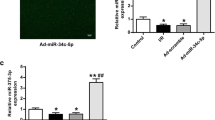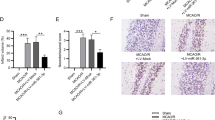Abstract
Non-coding RNAs have recently attracted much attention with the potential in the treatment of cerebral ischemia/reperfusion (I/R) injuries. In this study, we investigated the role of miR-32-5p in cerebral I/R injuries by using oxygen–glucose deprivation/reperfusion (OGD/R) PC12 cells and middle cerebral artery occlusion/reperfusion (MCAO/R) rats. The expression of genes and proteins were detected by RT-qPCR and Western blot, respectively. The function of OGD/R PC12 cells was detected using MTT assay and flow cytometry analysis. The influences of MCAO/R on rats was evaluated by measuring the infarct volume and brain water content. Bioinformatics analysis and luciferase gene reporter assay were used to identify the relationship between miR-32-5p and PTEN. The results showed that miR-32-5p had neuroprotective effects on OGD/R induced PC12 cells and MCAO/R injured rats’ brain. The level of miR-32-5p was significantly reduced after OGD/R. Overexpression of miR-32-5p significantly reduced MCAO/R-induced brain damages in rats. Moreover, PTEN was found to be a target of miR-32-5p, and overexpression of PTEN attenuated the effects of miR-32-5p overexpression on cerebral I/R injuries. In addition, miR-32-5p was able to activate PI3K/AKT signaling by inhibiting PTEN. In conclusion, miR-32-5p prevents brain I/R injuries through modulating PTEN/PI3K/AKT signaling pathway.
Graphic Abstract






Similar content being viewed by others
Data availability
The datasets used and analyzed in the current study are available from the corresponding author on reasonable request.
References
Arslan E, Gel MS et al (2019) The Effects of Rifampicin on Experimental Cerebral Ischemia/Reperfusion Injury in Rats. Iran Red Crescent Med J (In Press)
Dehaini H, Awada H et al (2019) MicroRNAs as Potential Pharmaco-targets in Ischemia-Reperfusion Injury Compounded by Diabetes. Cells 8(2):152
Gao ZQ, Wang JF et al (2017) Long non-coding RNA GAS5 suppresses pancreatic cancer metastasis through modulating miR-32-5p/PTEN axis. Cell Biosci 7(1):66
Guo QQ, Wu ZM et al (2014) Phenylboronate-diol crosslinked glycopolymeric nanocarriers for insulin delivery at physiological pH. Soft Matter 10(6):911–920
He H, Zeng Q et al (2019a) Bone marrow mesenchymal stem cell transplantation exerts neuroprotective effects following cerebral ischemia/reperfusion injury by inhibiting autophagy via the PI3K/Akt pathway. Brain Res 1707:124–132
He Q, Li Z et al (2019b) Parkin-Dependent Mitophagy Is Required for the Inhibition of ATF4 on NLRP3 Inflammasome Activation in Cerebral Ischemia-Reperfusion Injury in Rats. Cells 8(8):897
Jovin TG, Albers GW et al (2016) Stroke Treatment Academic Industry Roundtable: The Next Generation of Endovascular Trials. Stroke 47(10):2656–2665
Li P, Shen M et al (2017) An antagomir to microRNA-106b-5p ameliorates cerebral ischemia and reperfusion injury in rats via inhibiting apoptosis and oxidative stress. Mol Neurobiol 54(4):2901–2921
Li PF, Teng FM et al (2015) Identification of circulating microRNAs as potential biomarkers for detecting acute ischemic stroke. Cell Mol Neurobiol 35(3):433–447
Liang Y, Xu J et al (2018) Inhibition of miRNA-125b decreases cerebral ischemia/reperfusion injury by targeting CK2α/NADPH oxidase signaling. Cell Physiol Biochem 45(5):1818–1826
Ma J, Shui S et al (2017) microRNA-200a silencing protects neural stem cells against cerebral ischemia/reperfusion injury. PLoS ONE 12(2):e0172178
Party, ISW (2012) National clinical guideline for stroke, Citeseer
Savitz SI, Baron JC et al (2019) Stroke Treatment Academic Industry Roundtable X Brain Cytoprotection Therapies in the Reperfusion Era. Stroke 50(4):1026–1031
Sha R, Han X et al (2019) The Effects of Electroacupuncture in a Rat Model of Cerebral Ischemia-Reperfusion Injury Following Middle Cerebral Artery Occlusion Involves MicroRNA-223 and the PTEN Signaling Pathway. Medical Science Monitor: International Medical Journal of Experimental and Clinical Research 25:10077
Tao Z, Zhao H et al (2015) Neuroprotective effect of microRNA-99a against focal cerebral ischemia–reperfusion injury in mice. J Neurol Sci 355(1–2):113–119
Tian X, An R et al (2019) Tamibarotene Improves Hippocampus Injury Induced by Focal Cerebral Ischemia-Reperfusion via Modulating PI3K/Akt Pathway in Rats. J Stroke Cerebrovasc Dis
Trialists’ Collaboration, SU (2013) Organised inpatient (stroke unit) care for stroke. Cochrane Database Syst Rev 9(9)
Wang J, Cao B et al (2017) Long non-coding RNA H19 induces cerebral ischemia reperfusion injury via activation of autophagy. Aging Dis 8(1):71
Wang J, Wang A et al (2019) Trametenolic acid B protects against cerebral ischemia and reperfusion injury through modulation of microRNA-10a and PI3K/Akt/mTOR signaling pathways. Biomed Pharmacother 112:108692
Wang M, Sun Y et al (2018) Preclinical studies using miR-32-5p to suppress clear cell renal cell carcinoma metastasis via altering the miR-32-5p/TR4/HGF/Met signaling. Int J Cancer 143(1):100–112
Wang X, Shi C et al (2020a) MicroRNA-22 exerts its neuroprotective and angiogenic functions via regulating PI3K/Akt signaling pathway in cerebral ischemia–reperfusion rats. J Neural Transm 127:35–44
Wang ZW, Han YF et al (2020b) Lupeol Alleviates Cerebral lschemia-Reperfusion Injury in Correlation with Modulation of PI3K/Akt Pathway. Neuropsychiatr Dis Treat 16:1381–1390
Xiao Q, Ye QF et al (2017) Mild hypothermia pretreatment protects hepatocytes against ischemia reperfusion injury via down-regulating miR-122 and IGF-1R/AKT pathway. Cryobiology 75:100–105
Yang CC, Wei XP et al (2021) Down-regulating microRNA-20a regulates CDH1 to protect against cerebral ischemia/reperfusion injury in rats. Cell Cycle 20(1):54–64
Yang X, Ji H et al (2018) Downregulation of circ_008018 protects against cerebral ischemia–reperfusion injury by targeting miR-99a. Biochem Biophys Res Commun 499(4):758–764
Zhang YM, Liu JY et al (2021) Exosomal microRNA-22–3p alleviates cerebral ischemic injury by modulating KDM6B/BMP2/BMF axis. Stem Cell Res Ther 12(1)
Zheng T, Shi Y et al (2019) MiR-130a exerts neuroprotective effects against ischemic stroke through PTEN/PI3K/AKT pathway. Biomed Pharmacother 117:109117
Zheng Y, Zhao P et al (2019) MiR-340–5p alleviates oxygen-glucose deprivation/ reoxygenation-induced neuronal injury via PI3K/Akt activation by targeting PDCD4. Neurochem Int 104650
Acknowledgments
The authors would like to express our gratitude for those who have critically reviewed this manuscript and those who give us help during this experiment.
Funding
The research was supported by Shenzhen “Sanming Project” (grant no.: SZSM201610039), Science Technology Innovation and Industrial Development of Shenzhen Dapeng New District (Grand No. YL202001-14), and Scientific Research Project of Shenzhen Dapeng New District Medical and Health Group(Grand No. 2020JTLCYJ01).
Author information
Authors and Affiliations
Contributions
Yao Wang and Shangjie Chen were the guarantor of integrity of the entire study. Yulong Wang provided the study concepts. Yao Wang and Shangjie Chen designed the experiments. Weiyi Pan defined the intellectual content.
Corresponding author
Ethics declarations
Ethics approval
This study was approved by the Ethics Committee of Affiliated Baoan Hospital of Shenzhen, Southern Medical University.
Competing interests
The author reports no conflicts of interest.
Additional information
Publisher's Note
Springer Nature remains neutral with regard to jurisdictional claims in published maps and institutional affiliations.
Rights and permissions
About this article
Cite this article
Wang, Y., Pan, W., Wang, Y. et al. MicroRNA-32-5p attenuates cerebral ischemia/reperfusion injuries by modulating the phosphatase and tensin homologous protein. Metab Brain Dis 36, 2495–2504 (2021). https://doi.org/10.1007/s11011-021-00744-1
Received:
Accepted:
Published:
Issue Date:
DOI: https://doi.org/10.1007/s11011-021-00744-1




